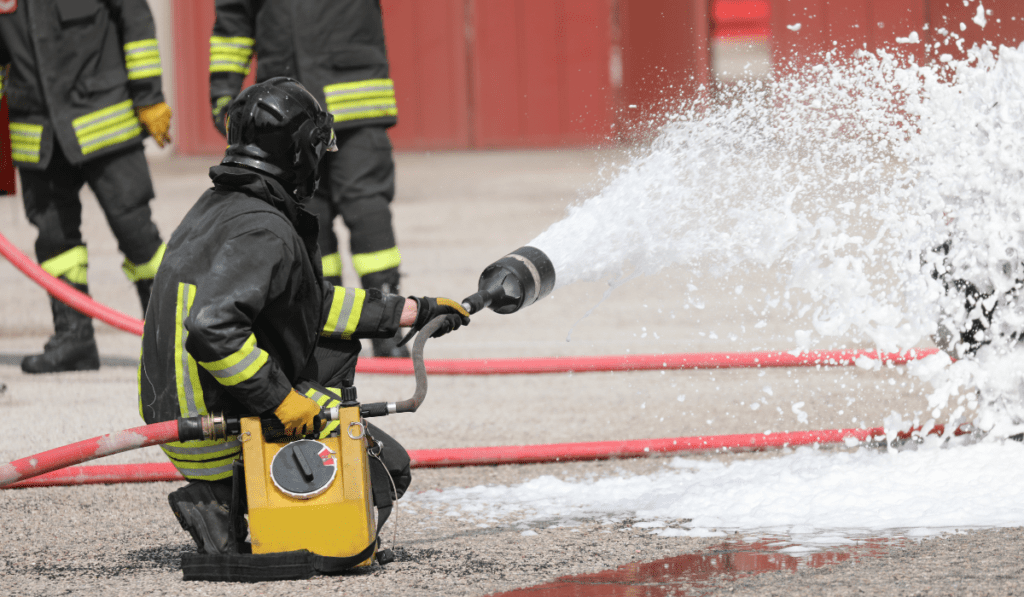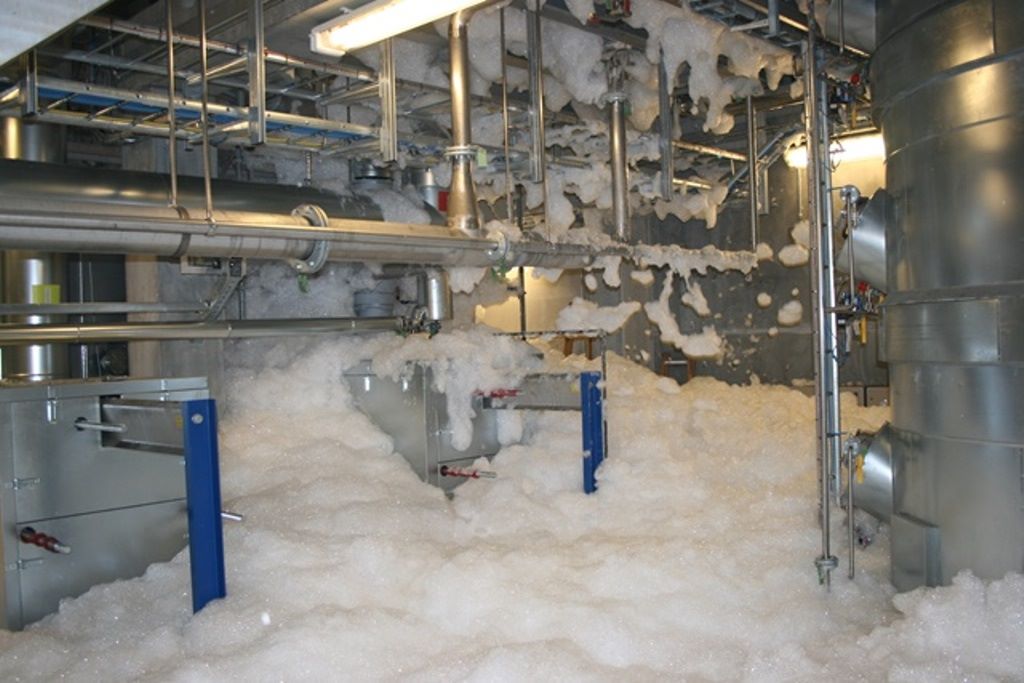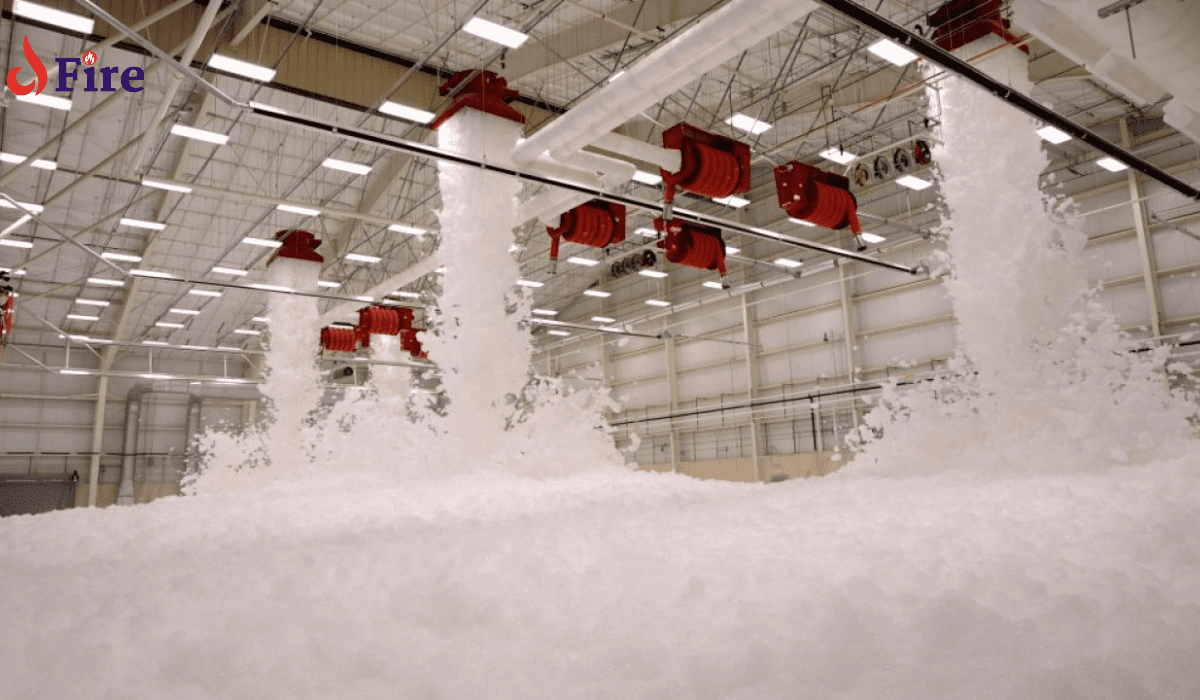A foam fire suppression system extinguishes fires by creating a blanket of foam that denies oxygen. This system is typically used for high-risk environments, such as aircraft hangars and fuel storage areas.
Fire incidents pose a substantial risk to safety and assets, especially in settings abundant in flammable materials. The sophisticated technology behind foam fire suppression systems addresses this risk effectively by deploying a combination of water and foam concentrate that expands when aerated through special discharge devices.
Upon activation, it rapidly spreads over the fire, creating a barrier that suffocates the flames and prevents reignition. This system’s swift action makes it invaluable for industrial, commercial, and even military applications where quick fire suppression is critical. By focusing on areas that suffer from the most extreme fire hazards, foam fire suppression systems provide a tailored solution that enhances safety and protects investments.
Introduction To Foam Fire Suppression Systems

Foam fire suppression systems are powerful tools for fighting fires. Designed for tackling tough blazes, these systems use a mix of water and foam. This mix blankets fires, cutting off oxygen. Understanding how they operate can be a game-changer for safety measures in various industries.
The Basics Of Fire Suppression
Fire suppression refers to the methods used to extinguish or prevent the spread of fire. Systems vary from water sprinklers to advanced gaseous agents. Early detection and a prompt response are key in effective suppression, saving lives and property.
- Fire Triangle: Understanding the components that fire need helps in stopping them.
- Types of Suppression Systems: Water-based, chemical, and inert gas systems play different roles.
- Regulatory Standards: Codes ensure systems meet safety requirements.
- Maintenance & Inspection: Regular checks guarantee operational readiness.
Role Of Foam In Extinguishing Fires
Foam suppression systems target the fuel and oxygen elements of the fire triangle. Foam blankets the fuel, creating a barrier against oxygen. This smothers the fire quickly, effectively snuffling out flames.
| Feature | Function |
|---|---|
| Cooling Effect | Reduces temperature, preventing re-ignition. |
| Separation | Blocks oxygen, suffocating the fire. |
| Suppression | Covers the fuel, stopping the fire spread. |
| Prevention | Minimizes vapor release from fuels. |
These systems are suitable for high-risk areas like airports and chemical plants. They offer quick extinguishing times and prevent further damage. This makes them ideal for scenarios with flammable liquids.
Types Of Foam Suppression Systems

The right foam fire suppression system can be the difference between a minor incident and a major disaster. These systems are critical in extinguishing fires that involve flammable liquids. They work by forming a blanket over the fire, cutting off the oxygen supply, and suppressing the flames. Understanding the different types of foam systems is crucial in selecting the most suitable option for specific risks.
High Expansion Systems
High Expansion Systems
High expansion foam systems are ideal for large areas such as hangars or warehouses. They produce a high volume of foam, which quickly fills large spaces, smothering flames effectively. Here’s a snapshot of its characteristics:
- Rapid fire suppression in vast, open areas.
- Perfect for Class A and B fires.
- Requires minimal water, limiting damage.
Low Expansion Systems
Low Expansion Systems
Low expansion foam systems provide a thick, dense foam layer. This foam type is excellent for covering smaller areas and for use on surfaces where the foam needs to cling to vertical sides to eliminate fires. Key points include:
- Highly effective on flammable liquid fires.
- Delivers a precise application for targeted fire fighting.
- Particularly suited for industrial environments.
Specialized Agents for Varied Fire Classes
Specialized Agents For Varied Fire Classes
Specialized foam agents are formulated to fight specific classes of fire. For instance, AFFF (Aqueous Film Forming Foam) is popular for its use on Class B fires, while AR-AFFF (Alcohol Resistant Aqueous Film Forming Foams) is designed to tackle fires involving polar solvents. Table detailing agents includes:
| Agent | Fire Class | Applications |
|---|---|---|
| AFFF | Class B | Petroleum storage, airfields |
| AR-AFFF | Class B | Chemical plants, refineries |
| FFFP | Class A & B | General firefighting |
Components And Operation
Have you ever wondered how large buildings stay safe from fire? A Foam Fire Suppression System is the answer. This system douses flames quickly and efficiently. Let’s break down the components that make this possible and explain how they operate.
Foam Concentrates And Mixers
The first step in the fire suppression process involves foam concentrates. These special liquids mix with water to create a fire-fighting foam. This mix happens in a device called a mixer. Mixers ensure the foam concentrate blends correctly with the water to become effective against fire. There are two types of mixers:
- Inline mixers, which blend the foam as water flows through.
- Bladder tank mixers where foam concentrate is stored in a bladder inside a water tank.
Delivery Systems And Discharge Devices
Once mixed, the foam needs to get to the fire. Delivery systems are a network of pipes that transport the foam solution. The discharge devices then release the foam. They come in different shapes like:
- Sprinkler heads in ceilings.
- Foam nozzles for directed application.
Control Panels And Activation Methods
The brain of the system is the control panel. It receives signals from fire detectors and triggers the suppression system. For initiation, two methods are common:
- Manual activation, where a person must activate the system.
- Automatic activation, using sensors that detect fire and start the system on their own.
Design And Installation Considerations
An effective Foam Fire Suppression System is crucial for safeguarding lives and property. The design and installation of such systems demand careful considerations to ensure optimal performance. Specific criteria must be met for the system to be efficient in the event of a fire. Let’s delve into the factors that contribute to a successful foam fire suppression system.
Assessing Fire Risks And Requirements
Identifying potential fire hazards is the first step in designing a foam fire suppression system. Factors such as the type of materials present, the likelihood of a fire, and the possible intensity of a blaze are critical in determining the requirements of a system. The analysis should result in a tailored solution that addresses the unique needs of a facility.
- Fuel type: Whether it be flammable liquids, gases or solid combustibles.
- Risk areas: Pinpointing high-risk zones within the premises.
- Fire load: Estimating the potential size and severity of a fire.
Space Configuration And Coverage Area
The layout and design of the space have a significant impact on the type and scope of a foam fire suppression system. Every nook and corner of the risk area must receive adequate coverage. Complex layouts may require additional suppression devices to ensure full coverage.
| Space Factor | Detail |
|---|---|
| Height | Ceiling and storage height may necessitate specific foam discharge densities. |
| Obstructions | Posts, beams, and other structures need consideration for unimpeded foam spread. |
| Ventilation | Airflow patterns can affect foam application and retention. |
Compliance With Fire Safety Standards
Adherence to legal and industry standards is not just a requirement but a responsibility. Codes such as NFPA 11 provide guidelines on low-, medium-, and high-expansion foam systems. Close collaboration with fire safety experts and local authorities ensures that the system’s design and installation meet all necessary compliance checkpoints.
- Study relevant fire safety codes.
- Secure necessary certifications.
- Implement recommended safety protocols.
- Ensure regular maintenance and inspections.
Manual Vs. Automatic Systems
Choosing the right Foam Fire Suppression System is vital for safety. Manual systems need a person to activate them. Automatic systems work on their own when a fire is detected. Both have their place. Knowing how each operates can inform your decision for installation.
Trigger Mechanisms And Human Interface
Manual systems rely on someone spotting a fire. That person must then activate the system. This usually involves pulling a lever or pressing a button. Automatic systems, however, have sensors. These sensors detect heat, smoke, or flames. Upon detection, the system gets to work right away, without waiting for human action.
Advantages Of Automatic Suppression
- Quick Response: Reduces fire spread by acting fast.
- 24/7 Protection: Works around the clock, even when no one is around.
- Minimized Damage: Early intervention limits harm to property.
- User Safety: People can focus on evacuating instead of fighting the fire.
Situations Favoring Manual Control
Some scenarios benefit from manual systems. If a site is always occupied, or if there’s a risk of automatic systems causing false alarms or unnecessary discharges, manual control gives humans the final say. It’s also the simpler choice for places where quick evacuation is a priority.
Performance And Limitations
Foam fire suppression systems play a crucial role in safeguarding against fire hazards. Their performance and limitations vary based on numerous factors. Understanding these can help pinpoint the optimal fire protection strategy for different environments and situations.
Effectiveness Across Fire Classes
Versatility is a key feature of foam fire suppression systems. They tackle different types of fires efficiently. Class A fires, involving common combustibles, and Class B fires, with flammable liquids, are particularly vulnerable to foam systems. Various foam formulations exist to deal with specialized scenarios—ensuring comprehensive protection.
- Class A: Excellent for penetrating and soaking into materials.
- Class B: Forms a barrier, preventing oxygen from fueling the flames.
Challenges With Certain Ignition Sources
Despite their strengths, foam fire suppression systems meet challenges with certain fires. High-intensity fires or those with specific ignition sources can render foam less effective. Electrical fires (Class C) or those involving metals (Class D) may require alternative methods for safe and effective extinguishment.
| Fire Class | Challenges |
|---|---|
| Class C | Electrically non-conductive mediums needed. |
| Class D | Special agents required to prevent metal reaction. |
Environmental Impact Of Foam Agents
Foam agents’ environmental footprint is a subject of growing concern. While highly effective, certain foaming agents contain chemicals that can pose risks to ecosystems. Perfluoroalkyl and polyfluoroalkyl substances (PFAS), once common in firefighting foams, are now closely regulated due to their persistence in the environment and potential health risks. Modern foam systems now use more environment-friendly alternatives to mitigate these concerns.
Maintenance And Testing
Maintaining optimal performance of a Foam Fire Suppression System ensures safety in emergencies. Regular maintenance and testing are critical. This process includes routine inspections, comprehensive system tests, and meticulous record-keeping. Protection against fire demands diligence and precision, so let’s delve into these crucial steps.
Routine Inspections And Servicing
Regular inspections prevent unforeseen system failures. These checks involve:
- Visual examinations for signs of damage or wear.
- Ensuring nozzles and discharge devices remain obstruction-free.
- Assessing foam concentration levels for consistency.
- Examining control panels and alert systems for functionality.
Qualified technicians should conduct servicing annually to replace parts and update system components.
Conducting System Tests
System tests replicate emergency scenarios. These evaluations ensure:
- Rapid activation of the foam fire suppression system.
- Appropriate foam discharge and coverage.
- Efficiency in suppressing fires under varied conditions.
Test outcomes inform necessary adjustments or repairs, keeping the system performance-ready.
Record-keeping And Documentation
Accurate records uphold system integrity. Documentation includes:
| Date | Activity | Technician | Findings |
|---|---|---|---|
| 01/01/2023 | Inspection | John Doe | No issues found |
Records verify compliance with fire safety regulations. Each entry should detail the date, activities performed, technician’s name, and any issues identified. These logs serve as a reference for future maintenance and support warranty claims.
Case Studies And Real-world Applications
Dive into the world of Foam Fire Suppression Systems through case studies and real-world applications. Understand how these systems save lives and property. Learn from past mishaps to anticipate the future of fire safety.
Successful Interventions In Industry
The power of foam fire systems shines in industries worldwide. Their success stories offer insights into their effectiveness.
- Chemical Plant Rescue: A Texas plant detected a flammable liquid spill. The foam system activated and averted a mega-fire.
- Aircraft Hangar Safety: In Germany, a foam suppression system quickly doused an aircraft fire, protecting multimillion-dollar assets.
Lessons Learned From System Failures
Failures unfold valuable lessons. We recount two tales where foam systems faltered.
- Incorrect Foam Concentration: In a US facility, subpar foam concentration led to fire spread. Precise mix ratios are critical.
- Delayed Activation: In Brazil, late system deployment resulted in losses. Timely response is the key to success.
Future Innovations And Improvements
The fire suppression landscape is evolving. We peek into what lies ahead.
Eco-friendly agents are on the rise, with a push for green solutions. Smart detection tech harnesses AI to predict and react to fires faster. The shift to modular designs presents customization that fits unique industry needs.
| Improvement | Description | Impact |
|---|---|---|
| Biodegradable Foams | Less environmental impact post-discharge | Higher sustainability in fire safety |
| Artificial Intelligence (AI) | Real-time fire analytics and predictive measures | Faster interventions saving more lives and property |
| Custom Systems | Adaptable to specific industrial needs | Better protection through tailored solutions |
Safety Protocols And User Training
Foam fire suppression systems play a crucial role in protecting lives and property from fire-related disasters. To ensure optimal performance and safety, strict safety protocols and comprehensive user training are essential components of any foam fire suppression system.
Operational Safety Measures
Understanding and implementing operational safety measures are key to maintaining a secure environment. These measures include:
- Regular inspection of nozzles and hoses for damages.
- Ensuring clear access to actuation controls.
- Verification of foam concentration levels for efficacy.
- Maintenance of storage tanks to prevent contamination.
Training Sessions For System Users
Effective training is crucial for those who manage and operate foam fire suppression systems. Key training points include:
- Understanding the system’s components and operation.
- Recognizing fire types and the appropriate foam to use.
- Conducting emergency response drills regularly.
- Proper maintenance practices to prevent malfunctions.
Quick Response To System Activation
When a foam fire suppression system activates, time is of the essence. Users must:
| Action | Importance |
|---|---|
| Evaluate the situation | Determines response urgency |
| Alert all occupants | Enhances safety |
| Contact emergency services | Ensures professional assistance |
| Initiate evacuation | Safeguards everyone on the premises |
Regulations And Legal Implications
Understanding the regulations and legal implications of Foam Fire Suppression Systems is crucial. These regulations ensure the safety of everyone. The industry has clear standards that property owners must follow. Failing to do so can result in penalties. Let’s dive into these crucial aspects.
Industry Standards And Certifications
Certifications are vital for safety and compliance in fire suppression systems.
- NFPA 11 outlines standards for foam fire systems.
- UL and FM provide safety certifications.
- International codes such as ISO also apply.
These standards ensure that every foam fire system works effectively.
Legal Obligations For Property Owners
Property owners have a duty to keep occupants safe. Foam fire systems must meet:
- Local fire codes.
- Building regulations.
- System maintenance requirements.
Owners must ensure systems are inspected regularly.
Penalties For Non-compliance
Ignoring these rules can lead to:
- Heavy fines for flouting codes.
- Legal action for failing to protect occupants.
- Potential closure of business premises.
It is imperative to comply with all regulations.

Credit: allegiantfire.net
Frequently Asked Questions On Foam Fire Suppression System
What Is A Foam Fire Suppression System?
A foam fire suppression system is designed to extinguish fires by spreading a foam blanket over the flames, cutting off the oxygen supply and cooling the fire.
How Does Foam Suppress Fires Effectively?
Foam suppresses fires by smothering the flames, separating the fuel from oxygen and cooling the heated materials, halting the combustion process.
Can Foam Systems Extinguish All Fire Types?
Foam fire suppression systems are most effective on Class B fires (flammable liquids) and not suitable for electrical or Class C fires without being de-energized first.
Are Foam Fire Suppression Systems Environmentally Friendly?
Some foam agents are eco-friendly, but traditional foams may contain substances harmful to the environment, prompting a shift towards greener alternatives.
What Maintenance Do Foam Systems Require?
Foam fire suppression systems require regular inspections, testing of foam concentrate, and checks of mechanical parts to ensure optimal performance.
When To Choose A Foam Fire System?
A foam fire suppression system is best chosen for high-risk areas involving flammable liquids, such as aviation facilities, fuel storage, and chemical plants.
Conclusion
Safeguarding against the ravages of fire hinges on reliable systems. Foam fire suppression stands as a steadfast ally in this battle. It smothers flames effectively, offering protection for varied environments. This system, crucial for safety, deserves consideration in your fire defense strategy.
Stay vigilant, stay protected.

I’m Abdus Sobur, a highly skilled and professional Fire Safety Officer with a passion for safeguarding lives and property. Over the course of my career, I’ve conducted numerous successful fire safety audits, earning a reputation for excellence in ensuring public safety.
In addition to my role as a Fire Safety Officer, I’m also dedicated to raising awareness about the importance of fire safety. Through my blog, I share insights into the functions of different fire safety equipment, aiming to empower individuals with the knowledge they need to protect themselves and their communities.
I’m driven by a deep commitment to promoting fire safety awareness and preventing fire-related incidents.

